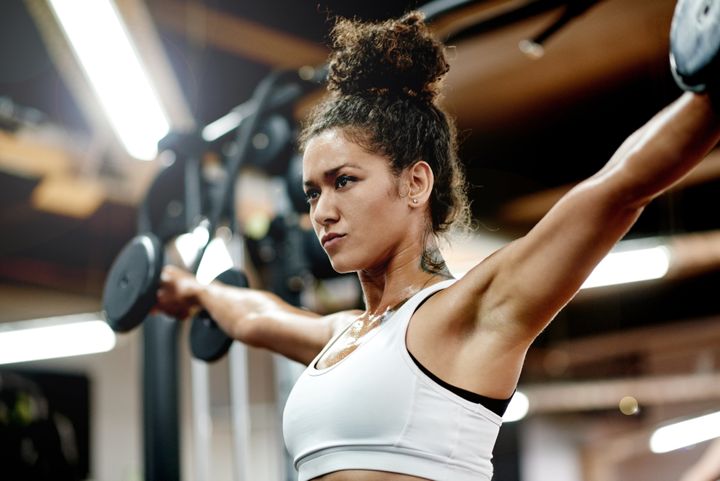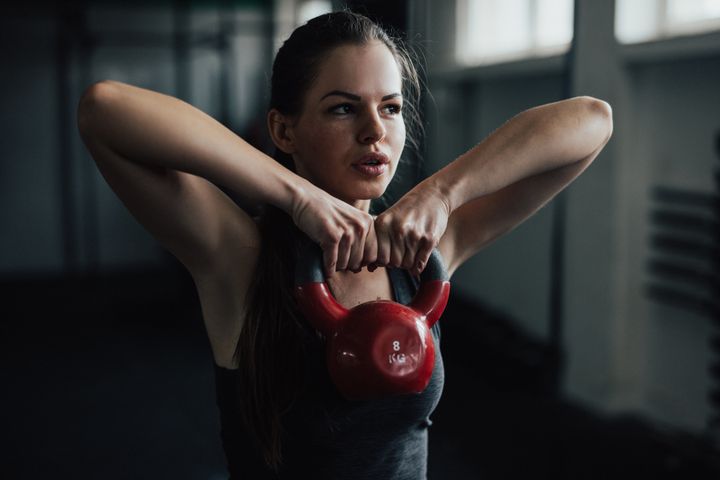You’re reading Move, the nudge we need to get active, however makes us happiest and healthiest.
We’ve been there – you get into the weights section of the gym and you’re the only woman. You don’t want to do anything wrong or be watched if you’re trying it for the first time, so you shy away and head back to the parts of the gym you know best.
Weight training for women is full of myths and misconceptions. Some believe it’ll make you “too bulky” and others assume it’s a workout exclusive to men.
“One of the barriers for women into sport is the fear of judgement, worrying that they won’t be very good,” says Kate Dale, strategic lead in This Girl Can.
“Lifting, and the associated notion of being powerful and strong, isn’t traditionally associated with femininity. But we’re keen advocates of reminding women that times are changing – get out there, have a go and show the world that This Girl Can Lift. It’s the feeling of being strong and seeing what your body can do which motivates people to start.”

Rather than make you bulky, weight training - in combination with cardio - is one of the best ways to maintain body fat and muscle ratio says Luke Chamberlain, personal trainer at DW Fitness First. When you have more muscle mass, you burn more calories per day, which makes managing body fat easier.
Strength training will also increase bone density and improve heart condition (through a lowered heart rate and lowered blood pressure), explains PT Lucy Arnold.
So if you’re just starting out or need some encouragement to get going, we asked a range of PTs their best tips and advice on getting started.
1. Do your research.
Don’t start weight training without knowing what you’re doing first. “Some expert advice is essential,” says Mark Briant, director of Mobfit. “Poor technique when lifting weights can do more harm than good in the long run.”
Speak to a personal trainer to work out what you want you want to achieve - they will be able to give you advice on how to get started depending on where you are in your fitness journey. They can also help you with technique, form and training programmes.
2. Master bodyweight movements first.
Don’t be hard on yourself when you’re starting out - getting things wrong is the quickest way to learn how to get it right. “You don’t need to jump in with heavy equipment,” says Bisi Adewumi, who weight trains. “You can start by using your own body. Walking lunges or push-ups are a great way of building strength to begin with.
“If you’re not sure about entering the weights area in the gym, don’t be afraid to use weights you have at home as a starting point. Water bottles or tins are perfect as pieces of ‘gym equipment’ you have readily available in your cupboard. Start there if you’re feeling nervous and use it to build your confidence.”
Briant agrees and says it’s always best to master the bodyweight movements first and ensure you are comfortable with them: “Can you perform 20 unbroken air squats, 10 push ups and hold a plank for a minute? If so you’re ready to add some resistance to your training.”

3. Start small with the weights.
When you move from bodyweight exercises to using weights, start small and build confidence. Chamberlain advises to lift light so that you have a bigger window for error without injury: “The heavier you go the smaller that window gets,” he says. “It’s essential to learn how to complete an exercise correctly before loading heavy. Building a foundation is important to understand how your body will react to weight lifting, it will help prevent injuries and give you the best long term progression.”
The best way to do this, Briant advises, is to set yourself a few simple goals and week by week, gradually increase your weights to ensure you keep progressing.
And don’t be afraid to get it wrong - we all have to start out somewhere and getting things wrong is the quickest way to lean how to get it right.
4. Work out with friends.
“Having a friend participating in the workout can make you feel a lot more confident - especially when walking into the weights area,” says Chamberlain.
“A gym buddy can keep an eye on your technique and assist you if needed. Watching your training partner is also a great way to learn how to effectively do the exercise. Working in a pair or a group helps you on days when your motivation might be low - you can encourage each other to keep at it.”
5. Don’t compare yourself to others.
Commonly associated with weight training is delayed onset muscle soreness (DOMS), but Chamberlain reminds us that everybody reacts differently to weight lifting so if this isn’t something you feel - don’t panic.
“You don’t have to ache the next morning for it to be an effective workout,” he says. ”Doing too much too fast and aching for a week after one workout won’t be as effective as utilising a lighter workload more consistently. Everybody reacts differently to weight lifting - some ache after the simplest training plan and others hardly ache at all.”
Move celebrates exercise in all its forms, with accessible features encouraging you to add movement into your day – because it’s not just good for the body, but the mind, too. We get it: workouts can be a bit of a slog, but there are ways you can move more without dreading it. Whether you love hikes, bike rides, YouTube workouts or hula hoop routines, exercise should be something to enjoy.

